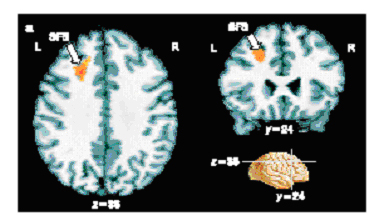 |
|
||||||||||||||||||
|
||||
| Perceptual Decision-Making Hub Pinpointed in Human Brain | ||||
|
A perceptual decision-making hub at the front of the brain makes the call on whether you’re looking at a face or a house — and likely many other things — scientists at the NIH’s National Institute of Mental Health (NIMH) have discovered. It works by gauging the strength of competing signals from lower brain areas specialized for recognizing different objects, report Drs. Hauke Heekeren, Leslie Ungerleider, and colleagues, in the October 14, 2004, Nature. Although earlier studies in monkeys had suggested that such a decision-making hub exists, its location in the human brain was not previously known. The researchers took advantage of the fact that it takes the brain longer to figure out what it’s looking at when an image is very blurred or obscured — like trying to recognize people standing on a street corner in a downpour versus on a clear day. Hard-to-discern images evoke a relatively slower and reduced response in the decision-making area, as it mulls the strength of competing signals from specialized visual processing areas, where neurons fire only to the extent that they see certain objects or features, the monkey studies showed. While their brain activity was monitored with functional magnetic resonance imaging (fMRI), twelve healthy subjects pressed buttons to indicate whether they saw a face or a house, as images flashed on a computer monitor. Some of the images were so noisy that they were barely discernable, reducing accuracy from 95 percent to 82 percent. The researchers looked for a site in the brain’s frontal cortex showing the telltale reduced activity during hard trials that coincided with activity in temporal lobe visual processing circuits that they had determined are specialized for responding to faces and houses, respectively. An area in the left front of the brain (dorsolateral prefrontal cortex) responded with more activity when images were easier to identify than when they were hard to discern. These responses also jibed with the difference between the signals emanating from the face and house specialized regions, indicating that it was the likely hub of perceptual decision-making. “It’s a relatively simple subtraction mechanism, but for a noisier stimulus, the decision may be a closer call,” explained Heekeren. “Responses of each specialized region may differ by only a little bit, and so it takes the brain longer to weigh each signal and make a decision.” The dorsal lateral prefrontal cortex site is also activated by other tasks, suggesting that it likely has general decision-making functions, note the researchers. Also participating in the study were Drs. Sean Marrett and Peter Bandettini, NIMH. 
Subjects in an MRI scanner pressed buttons to indicate whether they saw a face or a house for each of a series of obscured images flashed on a screen that were either easy (top) or hard (bottom) to identify. 
Researchers identified specialized visual processing regions low in the brain’s temporal lobe that responded selectively to faces (yellow) and houses (green). Activity in response to the noisiest/hardest images was less clear-cut than to less noisy/easy ones, leading to a slower and dampened response by the decision-making area in the frontal cortex. 
fMRI images show decision-making area in left dorsolateral prefrontal cortex. Source: NIMH Laboratory of Brain and Cognition, 2004 |
||||
| Top | ||||
| Posted: 10/18/2004 | ||||
| ||||
|